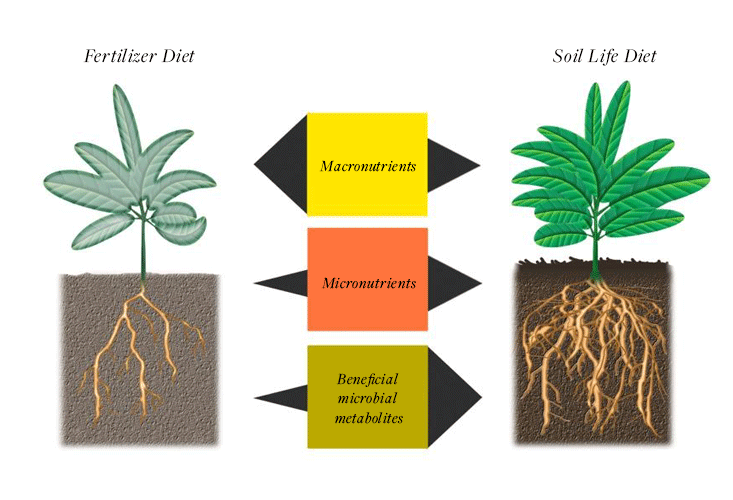Most of us are familiar with the much-maligned Western diet and its mainstay of processed food products found in the middle aisles of the grocery store. Some of us beeline for the salty chips and others for the sugar-packed cereals. But we are not the only ones eating junk food. An awful lot of crops grown in the developed world eat a botanical version of this diet—main courses of conventional fertilizers with pesticide sides.
It’s undeniable that crops raised on fertilizers have produced historical yields. After all, the key ingredients of most fertilizers—nitrogen (N), phosphorus (P), and potassium (K)—make plants grow faster and bigger. And popular insecticides and herbicides knock back plant enemies. From 1960 to 2000, a time when the world’s population doubled, global grain production rose even more quickly. It tripled.1
But there is a trade-off. High-yielding crops raised on a steady diet of fertilizers appear to have lower levels of certain minerals and nutrients. The diet our crops eat influences what gets into our food, and what we get—or don’t get—out of these foods when we eat them.

Agronomists who analyzed archived wheat samples collected from 1873 to 1995 found significant declines in iron and zinc.2 A 2009 study of nutrient levels in United States crops concluded that there was strong evidence for 5 to 40 percent declines in the mineral content of fruits and vegetables over the previous 50 to 70 years.3
There are multiple factors at play in declining nutrient levels. Among them is the trend in plant breeding for larger seed, grain, fruit, or vegetable size. Picture a big russet potato next to a small fingerling potato, both grown in the same soil and containing the same total amount of iron. Thanks to modern breeding techniques, the larger russet can contain less iron per unit of biomass than the smaller fingerling, making the russet less nutrient-dense.
Modern agriculture also influences phytochemical levels in food. These powerful bioactive compounds made by plants confer innumerable health benefits to themselves and the people who eat them. In general, the closer a crop type is to its wild ancestor, the higher its phytochemical levels.4 Yet NPK fertilizers translate into lower phytochemical levels. When plants grow explosively they tend to cut back on making phytochemicals.
We end up with big fat high-yielding crops that look good on the outside but are poor in minerals on the inside.
Central to the problem of declining mineral and phytochemical levels is what goes on in the out-of-sight world of a plant’s roots. From our human perch we marvel at what we think a plant’s life consists of—growing. The gnarly seed that sprouts into a soft green thing and the sapling that becomes a behemoth, understandably, catch our eye.
But the things that fuel plant growth on today’s farms, chiefly NPK fertilizers, are not the same things that plants need to stave off disease, heal from injuries, and fend off pests and pathogens. In other words, our big human brains have long, and erroneously, conflated plant growth with plant health. And herein lies a pickle for modern agriculture.
The recipe for plant health is complex. It goes considerably beyond the simple mix of N, P, and K that plants need to grow. Obtaining the dizzying number of ingredients in this recipe largely falls to the root microbiome—the vast menagerie of beneficial microbes, particularly bacteria and fungi, that swath and shield a plant’s roots. The root microbiome delivers many of its metabolites to a plant’s roots as well as minerals, other nutrients, and beneficial compounds found in the soil. This whole package bolsters the health of plants in myriad ways. Conveniently for the botanical host, the root microbiome also specializes in delivering the N, P, and K that they need to grow.
Reciprocity keeps symbioses humming along. In other words—no one, or at least very few, gets a free lunch. A plant host won’t hand over its goods unless it receives what it needs from its root microbiome and vice versa. And plants have the right infrastructure to support such exchanges. Roots are not simply sucking straws. They deliver their goods to the root microbiome through pumping exudates—a homemade brew of carbohydrates, phytochemicals, and other edibles—into the soil.
Exudates anchor a plant’s symbiotic relationship with its root microbiome. And the amount of energy a plant dedicates to producing and handing out these nutritional goodies—sometimes more than a third of the carbon that a plant captures through photosynthesis—attests to the exudates’ significance.5 This is why plants won’t make them, or hand them over, without a compelling reason.
A plant that feeds its root microbiome ample exudates is a plant that receives N, P, and K plus the health-promoting goods of the root microbiome in return. Among these goods are those that perform chemical signaling at the heart of crosstalk between a plant and its root microbiome. This, along with some exposure to pests and pathogens, tees up plants to make phytochemicals.
But when crops gorge on free NPK fertilizers it monkey-wrenches the symbiotic way of life for plant and root microbiome alike. Nothing, not even a brainless plant, is going to expend a third of its energy on something that can be had for free. And so their green bodies crank down exudate production. The consequence? A root microbiome that produces fewer metabolites beneficial to plants. A fertilizer-fed plant may not need N, P, and K deliveries from its root microbiome, but in forgoing these things it loses out on the other things that the root microbiome delivers that foster plant health.
So we end up with big fat high-yielding crops that look good on the outside but are poor in minerals and phytochemicals on the inside. This state of affairs is a calamity for a plant. A shuttered, starving root microbiome is the great undoing of the botanical worlds’ strategy for coupling a just-right rate of growth with a formidable built-in arsenal and pharmacy.

Standing around on top of the ground trying to get your arms around this colossal problem is futile. We need to go underground, to a wild and alive place beneath our feet called the rhizosphere (“rhizo” is from the Greek rhiza meaning “root”) to understand the intertwined story of plant growth and plant health from a plant’s-eye view.
The halo-like zone of the rhizosphere extends from a few millimeters to a centimeter or so around every single root and root hair. This special place is where you’ll find the root microbiome. The rhizosphere contains more life per unit area than anywhere else in the soil; some think more than anywhere else on the planet.
There is a simple reason the rhizosphere is the site of an incredible amount of activity. Plants use one of the oldest tricks in life’s playbook—free food—to ensure that the rhizosphere remains a bustling biological bazaar. People do this too. Are you the one who brings donuts to attract co-workers to early-morning meetings or the person who shows up to get one?
The purpose of the free food that plants provide is to recruit beneficial microbes into the rhizosphere. And guess who comes to lap up the phytochemicals and other edibles? Hungry bacteria, fungi, and other microbes with near-insatiable appetites for exudates, especially carbohydrates, which give them a ready-to-go energy source.
Soils rich in organic matter are like human diets rich in fiber. Each is an important food source for the root and gut microbiomes, respectively.
In addition to exudates, microbes in the rhizosphere also eat organic matter in the soil, transforming it into nutrients and compounds that plants need. But before organic matter gets to plants, it has to get to the soil and go through a lot of other organisms. Think of all the leaves that plants drop on top of the soil each fall. Larger forms of soil life, like liver-colored earthworms and arthropods sporting oversized mandibles, take the first run at breaking down organic matter. They chomp, chew, shred, and slice it into smaller pieces, which in one way or another puts food on the plates of smaller soil dwellers all the way down the line to the tiniest creatures on Earth—the microbes. This eat and be-eaten world turns decay into renewal. And microbes have the honor of carrying the baton of organic matter over the last hurdle in the race around the wheel of life.
Soils rich in organic matter are like human diets rich in fiber. Each is an important food source for the root and gut microbiomes, respectively. So long as a supply of organic matter replenishes the soil, it powers the cycle of eating, pooping, and dying among soil life that supports the entire botanical world. Microbe-manure in the soil is laden with N, P, and K. And dead microbes are an especially rich source of readily available nitrogen.
But N, P, and K are just the growth-fueling nutrients. A well-fed root microbiome also gives crops what a fertilizer and pesticide diet can never deliver—the full complement of essential minerals and a dazzling array of microbial metabolites and other compounds critical to the overall health of their green bodies.
So what can an organic-matter-chowing, exudate-chugging root microbiome do for its plant host? Plenty. Mycorrhizal fungi are a good place to start. When well-fed, they not only mine the minerals out of rocks, they bring them right to a plant’s doorstep, and in some cases right inside a plant’s green body. Among these minerals are those for which agronomists have documented declines in crops over time.
The minerals considered essential to plant health as well as our own number roughly a dozen or so. They do an enormous number of things in plants. The familiar ones, like zinc and iron, help build a plant’s fruits and vegetables. The not-so-familiar tongue-twisting mouthful, molybdenum, helps plants use nitrogen and turn sunlight into carbohydrates.
For a variety of reasons, however, plant roots generally need help to take up sufficient amounts of minerals. Mycorrhizal fungi assist them. Such fungi can double or triple a plant’s nutrient uptake per unit root length.6 The root-like hyphae of fungi act as long-distance conduits, that, in effect, extend a plant’s roots. One end connects to a root, the other to a store of minerals often beyond the physical reach of roots.
Tinkering with time-tested arrangements turns plants into botanical slackers.
But keeping in step with the no-free lunch rule, these fungi will only fetch and deliver a steady supply of minerals so long as a plant hands over nourishing exudates. So when plants get NPK for free from fertilizers, they pump out far fewer exudates, and mycorrhizal fungi dial down mineral and phosphorous deliveries to almost nothing. The pesticide handmaidens that accompany NPK fertilizers can also interfere with nutrient delivery and scramble chemical signaling between mycorrhizal fungi and their plant host.
When all is well in the rhizosphere, however, the root microbiome can do transformative work. Certain beneficial bacteria will eat tryptophan, an amino acid in root exudates, and return it to the plant as indole-3-acetic acid, one of the botanical world’s most important growth hormones. As a result, roots grow longer, lateral roots develop, and more root hairs sprout. With a more extensive root system, plants can absorb more nutrients and pump more exudates into the soil to recruit more helpful microbes that can make more indole-3-acetic acid. It’s a classic positive feedback loop.7
Perhaps most striking, plants can enlist their root microbiome to beat back pathogens like the widespread Pseudomonas syringae. This pathogenic bacterium can infest plant leaves, stems, buds, and flowers, causing a nasty infection and a lot of sick plants. When P. syringae shows up, a plant sends a chemical message down to its roots. Root cells release malic acid, which acts like a shepherd’s whistle. The bacterium Bacillus subtilis comes running and starts to colonize the roots. This signals the plant to get busy making phytochemicals and other defensive compounds to repel P. syringae. It doesn’t stop there. B. subtilis also induces plants to shut down the tiny openings on leaf surfaces, called stomata, which prevents more P. syringae from slithering into the botanical castle.8
As you can see, the rhizosphere is the place for microbes and plants to carry on the nutrient transfers and chemical signaling that forms the foundation for their symbiotic relationship. Plants are not giving away the farm. They get a lot in return.

Recall that plants expend a substantial amount of energy to make their exudate brews of sugars, vitamins, organic acids, and phytochemicals. Although expensive, the payoff is impressive, particularly in terms of phytochemicals. A single plant may contain hundreds to thousands of different kinds. One of the best-studied groups of phytochemicals, the polyphenols, has more than 8,000 different types.9
Spurred into action through chemical signaling from the root microbiome and direct attacks of pests, a plant switches on its phytochemical factories to re-stock its on-board arsenal and pharmacy. This can endow plants—crops, to put a fine point on it—with a built-in health plan. Some phytochemicals, like the glucosinolates found in the cabbage family, transform into a “mustard oil bomb” upon an ill-placed chomp from an insect herbivore. A mouthful of this noxious mess and the offender succumbs or hotfoots it to a different plant. Another group, the benzoxazinoids, perform complex signaling that grass family species like corn, wheat, and rye use to repel microbial pathogens.
Ever wonder why beta-carotene is in your sunscreen? It’s a type of phytochemical that protects plants from ultraviolet radiation. Another kind, flavonoids, attract the kinds of bacteria that live in or on plant roots and convert gaseous nitrogen into a form that plants can use. If released in root exudates, other types of flavonoids can, with a little help from the root microbiome, solubilize iron, copper, and zinc in the rhizosphere. This allows plants to slurp up these vital minerals.
Long before agrochemical companies existed, the botanical world relied on the phytochemicals it churned out to remain healthy. Couple their internal chemical factories with cultivating a root microbiome and you have the secret weapon that helped plants conquer the continents over the past 450 million years. Tinkering with these time-tested and co-evolved arrangements, however, can turn plants into botanical slackers.
A plant satiated on NPK fertilizers reaches for the exudate tap with leafy hands and turns it down to a trickle. Crops can get by without help from their microbial friends once the growth-spurring nutrients from a farmer start coursing through their green bodies. And once agrochemical poisons beat back pests and pathogens, plants idle their marvelous phytochemical factories. Why produce an energetically expensive mustard oil bomb if there are no herbivores around?
This situation spurs plants to make fewer defensive phytochemicals, as well as those that serve as nutrients bound for the bustling rhizosphere. These events translate into less food for the root microbiome. As it begins to starve, the supply of plant health-promoting metabolites it previously delivered to its plant host plummets, and their once vibrant chemical chatter falls quiet. This cements the negative feedback that begins with raising crops on a junk-food diet. A plant’s roots go from being a vital, two-way trade zone to one-way straws sucking up fertilizers.
Loading up soils with copious amounts of nitrogen fertilizer also has another downside. Faced with an all-you-can-eat buffet, that’s exactly what a plant’s green body sets out to do. They shunt a good deal of the energy they make through photosynthesis to building biomass, shortchanging themselves on the energy they need to make phytochemicals.10 Ramping down phytochemical production depletes a plant’s homemade arsenal and pharmacy, making them as vulnerable as a sick animal within sight of a predator. And so we swoop in—dousing couch-potato crops and soils with poisons to do what plant phytochemicals and root microbiomes have done for millions of years.
Anne Biklé is a biologist and gardener and David R. Montgomery is Dean’s professor of geomorphology at the University of Washington and a MacArthur Fellow. They are co-authors of The Hidden Half of Nature: The Microbial Roots of Life and Health. Follow them on Twitter @dig2grow, or visit their Website, www.dig2grow.com.
References
1. Bourne, J.K. The End of Plenty: The Race to Feed a Crowded World W.W. Norton, New York, NY (2015).
2. Garvin, D.F. Historical shifts in the seed mineral micronutrient concentration of U.S. hard red winter wheat germplasm. Journal of the Science of Food and Agriculture 86, 2213-2220 (2006).
3. Davis, D.R. Declining fruit and vegetable nutrient composition: What is the evidence? Horticultural Science 44, 15-19 (2009).
4. Robinson, J. Eating on the Wild Side Little Brown and Company, Boston, MA (2013).
5. van Dam, N.M. & Bouwmeester, H.J. Metabolomics in the rhizosphere: Tapping into belowground chemical communication. Trends in Plant Science 21, 256-265 (2016).
6. McNear Jr., D.H. The rhizosphere—roots, soil and everything in between. Nature Education Knowledge 4(3):1 (2013).
7. Idris, E.E., Iglesias, D.J., Talon, M., & Borriss, R. Tryptophan-dependent production of indole-3-acetic acid (IAA) affects level of plant growth promotion by Bacillus amyloliquefaciens FZB42. Molecular Plant-Microbe Interactions 20, 619–626 (2007).
8. Rudrappa, T., Czymmek, K.J., Pare, P.W., & Bais, H.P. Root-secreted malic acid recruits beneficial soil bacteria. Plant Physiology 148, 1547-1556 (2008).
9. Pandey, K.B. & Rizvi, S.I. Plant polyphenols as dietary antioxidants in human health and disease. Oxidative Medicine and Cellular Longevity 2, 270-278 (2009).
10. Baranski, M., et al. Higher antioxidant and lower cadmium concentrations and lower incidence of pesticide residues in organically grown crops: a systematic literature review and meta-analyses. British Journal of Nutrition 112, 794-811 (2014).
The lead photo is courtesy of Anna Fox/Flickr.



















